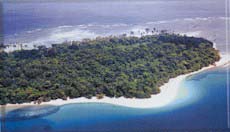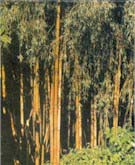| Destinations
|
|||||||||
One of the world's last outposts of virgin rain forest islands, the Andaman & Nicobar Islands are a string of 300 odd islands in the Bay Of Bengal. Remote, not easily accessible, it was preserved the way it had evolved, still inhabited by tribes considered to be the oldest living communities in the world. |
More on Andamans • Geography • History • People • Economy • Climate • Port Blair
Travelogues |
||||||||
Located between the Indian mainland and the long Burma (Myanmar) coast up to Sumatra, these coral islands with a unique ecology of its own, were till recently inhabited by tribals. The islands were annexed by the British in the 19th century and used as a penal colony for Indian freedom fighters. During World War II, the Japanese occupied the islands and created their own record of cruelty. The local tribes took up guerrilla activities against the Japanese. After India gained independence in 1947, the islands were incorporated into the Indian Union. Port Blair is the administrative headquarters of islands. The Andaman and Nicobar Islands comes under the rule of the central Government of India.
The main aboriginal group in the Andamans are the Onges, who live on Little Andaman. Onges, like other Andamanese tribes, are of Negrito origin. They are food-gatherers who hunt, fish and collect honey, and are the only tribe on the islands, who freely accept contact with the outside world. In the Nicobars, the only aboriginals are the Shompens, who are averse to any contact with the outside world. The Nicobarese, the largest group, seem to be of mixed Burmese, Malay, Mon and Shan origin. They are a friendly and cheerful lot, who do not accept money and prefer the barter system. Communing with the dead is one of the many intriguing rituals practiced in Nicobar. Compiled by Puneet Sachdeva
|
|||||||||
Editor: Romola Butalia (c) India Travelogue. All rights reserved. |
|||||||||
 A fantasy world of silver sands, clear blue seas, coral reefs,
swaying palms, tropical forests, volcanic mountains and a
gently undulating landscape. Boasting of an idyllic landscape
and immense natural attractions, it is one of the popular
tourist destinations in the country.
A fantasy world of silver sands, clear blue seas, coral reefs,
swaying palms, tropical forests, volcanic mountains and a
gently undulating landscape. Boasting of an idyllic landscape
and immense natural attractions, it is one of the popular
tourist destinations in the country.

 The capital of this Union Territory is Port Blair, on the
Andaman Islands, which is the landing and departure point for
boat excursions in the Andamans and an ideal base for touring
the archipelago of 321 islands. The island has been named
after Lt. Reginald Blair, who conducted a survey of the area,
in 1789. One of the fascinating features of the land that can
be seen throughout the islands, is that of houses built on
poles. The island also houses all the administrative and
government buildings and people from all parts of the world
live here, thus, giving it a rather cosmopolitan look.
The capital of this Union Territory is Port Blair, on the
Andaman Islands, which is the landing and departure point for
boat excursions in the Andamans and an ideal base for touring
the archipelago of 321 islands. The island has been named
after Lt. Reginald Blair, who conducted a survey of the area,
in 1789. One of the fascinating features of the land that can
be seen throughout the islands, is that of houses built on
poles. The island also houses all the administrative and
government buildings and people from all parts of the world
live here, thus, giving it a rather cosmopolitan look.